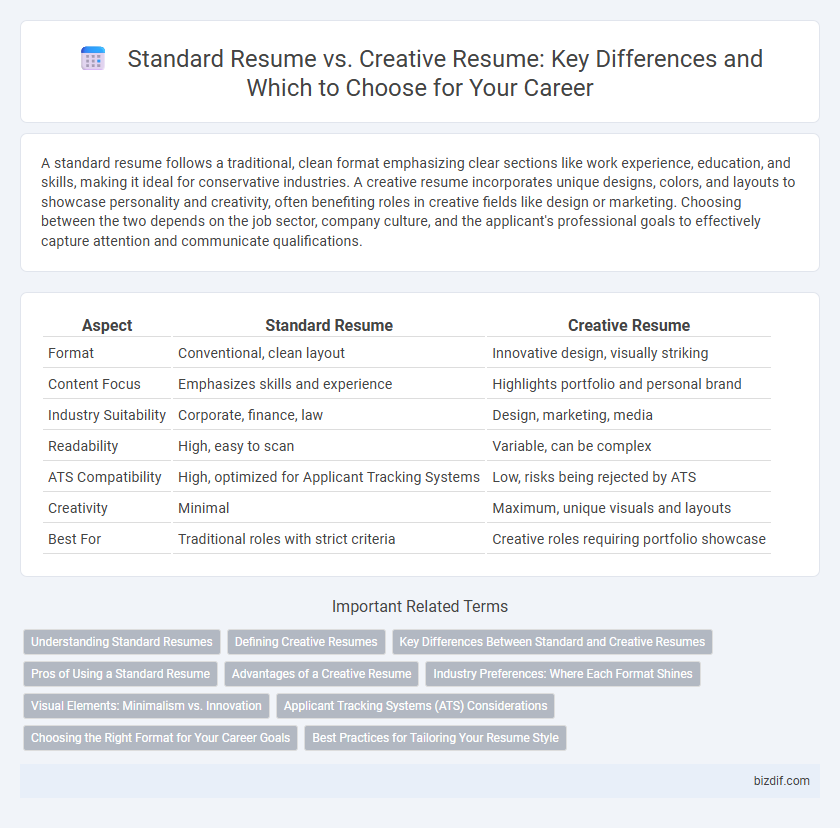A standard resume follows a traditional, clean format emphasizing clear sections like work experience, education, and skills, making it ideal for conservative industries. A creative resume incorporates unique designs, colors, and layouts to showcase personality and creativity, often benefiting roles in creative fields like design or marketing. Choosing between the two depends on the job sector, company culture, and the applicant's professional goals to effectively capture attention and communicate qualifications.
Table of Comparison
| Aspect | Standard Resume | Creative Resume |
|---|---|---|
| Format | Conventional, clean layout | Innovative design, visually striking |
| Content Focus | Emphasizes skills and experience | Highlights portfolio and personal brand |
| Industry Suitability | Corporate, finance, law | Design, marketing, media |
| Readability | High, easy to scan | Variable, can be complex |
| ATS Compatibility | High, optimized for Applicant Tracking Systems | Low, risks being rejected by ATS |
| Creativity | Minimal | Maximum, unique visuals and layouts |
| Best For | Traditional roles with strict criteria | Creative roles requiring portfolio showcase |
Understanding Standard Resumes
Standard resumes emphasize a clear, structured format with sections for work experience, education, and skills, ensuring easy readability and ATS (Applicant Tracking System) compatibility. They prioritize concise bullet points and chronological order to highlight professional achievements and qualifications relevant to the job. Understanding the simplicity and formality of standard resumes helps candidates present their background in a universally accepted manner favored by many employers.
Defining Creative Resumes
Creative resumes emphasize innovative design, unique layouts, and personalized visuals to showcase individuality and creativity, often used in artistic or design-focused industries. Unlike standard resumes, which prioritize structured formatting and clear, concise information, creative resumes utilize colors, graphics, and unconventional formats to capture attention and demonstrate a candidate's personality. Employers in creative fields often value these resumes for their ability to reflect candidates' originality and skills beyond traditional text.
Key Differences Between Standard and Creative Resumes
Standard resumes emphasize a clean layout, uniform fonts, and chronological order, prioritizing clarity and professionalism for traditional industries like finance and law. Creative resumes incorporate unique designs, vibrant colors, and unconventional formats to showcase personality and innovation, often favored in creative fields such as marketing, design, and media. The key differences lie in presentation style, level of visual creativity, and alignment with industry expectations, impacting how recruiters perceive applicant suitability.
Pros of Using a Standard Resume
Standard resumes offer a clear structure, making it easier for hiring managers to quickly find key information such as work experience, education, and skills. They adhere to widely accepted formats that increase compatibility with Applicant Tracking Systems (ATS), improving the chances of passing automated screening. The professional appearance and straightforward layout of standard resumes project reliability and seriousness, which are highly valued in traditional industries like finance, law, and corporate roles.
Advantages of a Creative Resume
Creative resumes stand out by showcasing unique design elements and personalized content, capturing the attention of hiring managers more effectively than standard resumes. They highlight an applicant's individuality and creativity, which is particularly advantageous in industries like marketing, design, and media. Incorporating visuals, infographics, and unconventional layouts enhances readability and leaves a memorable impression, increasing the chances of progressing in competitive job markets.
Industry Preferences: Where Each Format Shines
Standard resumes excel in traditional industries such as finance, healthcare, and law, where clear, concise, and easily scannable formats prioritize professionalism and relevant qualifications. Creative resumes thrive in sectors like marketing, design, and media, where innovation and personality in visual presentation highlight a candidate's unique skills and creativity. Understanding industry preferences ensures that job seekers choose the resume format that best aligns with employer expectations and enhances their chances of securing interviews.
Visual Elements: Minimalism vs. Innovation
Standard resumes emphasize minimalism with clean layouts, limited color palettes, and straightforward fonts to ensure clarity and easy scanning by applicant tracking systems (ATS). Creative resumes prioritize innovation through bold visuals, unique typography, infographics, and personalized design elements that showcase individuality and creativity. Balancing visual appeal with readability is essential to maintain professionalism while making a memorable impression.
Applicant Tracking Systems (ATS) Considerations
Standard resumes are preferred for Applicant Tracking Systems (ATS) as they use simple layouts and common fonts that ensure accurate parsing of keywords and information. Creative resumes often include graphics, unconventional formats, and intricate designs that can confuse ATS software, resulting in missed data or lower rankings. Optimizing a resume for ATS involves prioritizing clear section headings, keyword integration, and straightforward formatting to maximize visibility in automated screenings.
Choosing the Right Format for Your Career Goals
Selecting the right resume format depends on your career objectives and industry expectations. Standard resumes, with clear sections and traditional layouts, suit conservative fields like finance or law where clarity and professionalism are paramount. Creative resumes, featuring innovative designs and visual elements, appeal to roles in marketing, design, or entertainment where showcasing personality and originality can set candidates apart.
Best Practices for Tailoring Your Resume Style
Standard resumes emphasize clear formatting, concise language, and industry-specific keywords to pass applicant tracking systems (ATS) and appeal to traditional recruiters. Creative resumes leverage distinctive layouts, graphics, and personal branding elements to showcase originality and capture the attention of hiring managers in design or marketing fields. Tailor your resume style by aligning it with the job description, company culture, and industry expectations, ensuring relevance while maintaining readability and professionalism.
Standard Resume vs Creative Resume Infographic

 bizdif.com
bizdif.com